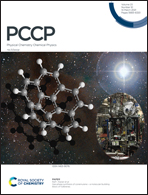Cycloaddition between nitrogen-doped graphene (6π-component) and benzene (4π-component): a theoretical approach using density functional theory with vdW-DF correction†
Abstract
The interaction between nitrogen-doped graphene defects (N3V1 and N4V2 pyridinic, and N3V1 and N3V3 pyrrolic) and benzene have been investigated by applying density functional theory (DFT), together with the vdW-DF correction. We discovered that only the N3V3 pyrrolic defect is a reactive site (6π-component), forming a cycloadduct with benzene (4π-component) that has energy barriers below 154.38 kJ mol−1 (1.60 eV). The conduction and valence bands (HOMO and LUMO) for N3V3 form a degenerate pair of orbitals at the gamma point, with the same ionization potential (IP) and electron affinity (EA). Likewise, inspection of the orbital symmetries for both systems confirms that these must undergo concerted reactions based on the Woodward and Hoffmann principles of orbital symmetry, with the appropriate orbital occupancies. This is the first time that substitutionally doped graphene has been demonstrated to participate as a 6π-component for cycloaddition reactions with benzene.



 Please wait while we load your content...
Please wait while we load your content...